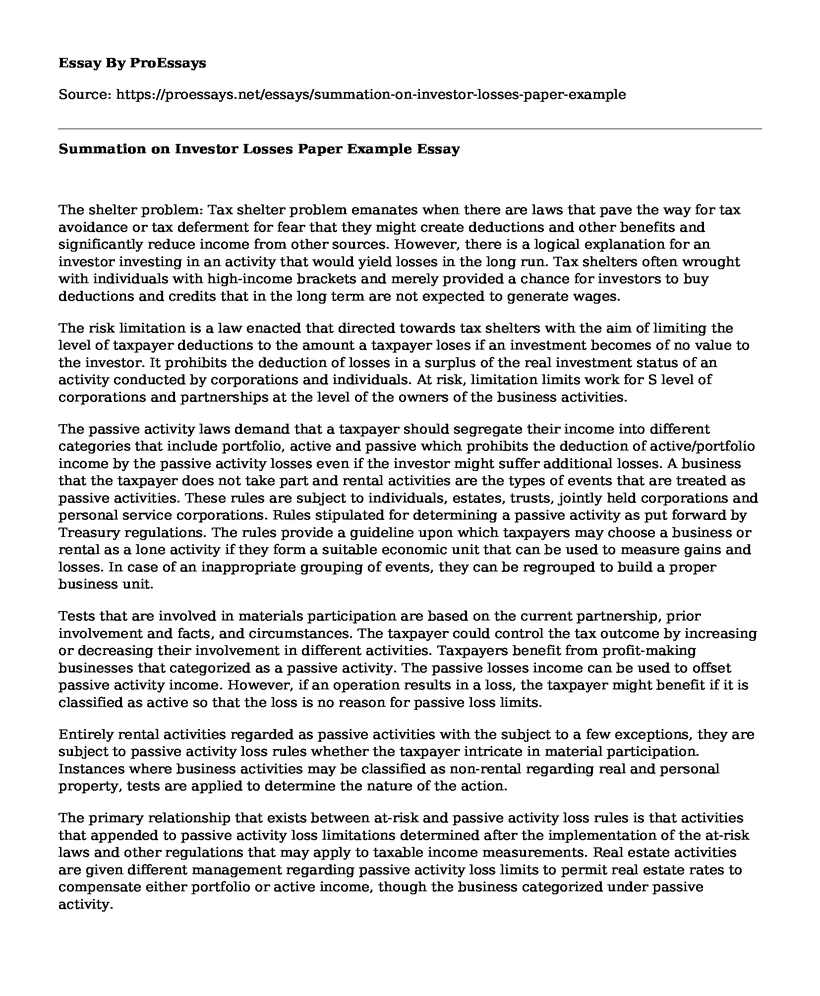The shelter problem: Tax shelter problem emanates when there are laws that pave the way for tax avoidance or tax deferment for fear that they might create deductions and other benefits and significantly reduce income from other sources. However, there is a logical explanation for an investor investing in an activity that would yield losses in the long run. Tax shelters often wrought with individuals with high-income brackets and merely provided a chance for investors to buy deductions and credits that in the long term are not expected to generate wages.
The risk limitation is a law enacted that directed towards tax shelters with the aim of limiting the level of taxpayer deductions to the amount a taxpayer loses if an investment becomes of no value to the investor. It prohibits the deduction of losses in a surplus of the real investment status of an activity conducted by corporations and individuals. At risk, limitation limits work for S level of corporations and partnerships at the level of the owners of the business activities.
The passive activity laws demand that a taxpayer should segregate their income into different categories that include portfolio, active and passive which prohibits the deduction of active/portfolio income by the passive activity losses even if the investor might suffer additional losses. A business that the taxpayer does not take part and rental activities are the types of events that are treated as passive activities. These rules are subject to individuals, estates, trusts, jointly held corporations and personal service corporations. Rules stipulated for determining a passive activity as put forward by Treasury regulations. The rules provide a guideline upon which taxpayers may choose a business or rental as a lone activity if they form a suitable economic unit that can be used to measure gains and losses. In case of an inappropriate grouping of events, they can be regrouped to build a proper business unit.
Tests that are involved in materials participation are based on the current partnership, prior involvement and facts, and circumstances. The taxpayer could control the tax outcome by increasing or decreasing their involvement in different activities. Taxpayers benefit from profit-making businesses that categorized as a passive activity. The passive losses income can be used to offset passive activity income. However, if an operation results in a loss, the taxpayer might benefit if it is classified as active so that the loss is no reason for passive loss limits.
Entirely rental activities regarded as passive activities with the subject to a few exceptions, they are subject to passive activity loss rules whether the taxpayer intricate in material participation. Instances where business activities may be classified as non-rental regarding real and personal property, tests are applied to determine the nature of the action.
The primary relationship that exists between at-risk and passive activity loss rules is that activities that appended to passive activity loss limitations determined after the implementation of the at-risk laws and other regulations that may apply to taxable income measurements. Real estate activities are given different management regarding passive activity loss limits to permit real estate rates to compensate either portfolio or active income, though the business categorized under passive activity.
Disposition of a passive activity has a proper tax treatment when a taxpayer intends to dispose of a whole interest gunned in a passive activity, any suspended losses available used while calculating the final economic gain or loss on the investment. In the case of a business failure resulting from disposition, the loss can be used to settle other types of income.
With the aim of the congress limiting the deductibility of investment interest that is paid on the debt borrowed, restrictions have been placed on the deductibility of the investor loss and deductions. This is done because of the procuring of asset property. The deduction is limited to the net investment income of a taxpayer; surplus investment is susceptible to inferences in future.
Tax planning strategies were put forward to minimize the effects of the passive activity loss and investment and the loss of current deductions. When a specific amount is borrowed for the financing the purchase of a passive activity, the related interest expenses regarded as part of any passive activity loss. If an investor lacks readily available cash for a substantial down payment, the additional money can be obtained by borrowing against the equity of the taxpayers' residence which is subject to a reduction in the category of qualified residence interest rules and not passive activity loss limitations.
References
William H. Hoffman (2018). South-Western Federal Taxation: Individual Income Taxes, Chapter 11, 41, 11-1-11-27.
Cite this page
Summation on Investor Losses Paper Example. (2022, May 26). Retrieved from https://proessays.net/essays/summation-on-investor-losses-paper-example
If you are the original author of this essay and no longer wish to have it published on the ProEssays website, please click below to request its removal:
- Cost Behavior Analysis: Auburn Circular Club
- Edwina's Small Business Analysis
- Calculating Return on Security Investment (ROSI) - Essay Sample
- Essay Sample on WorldCom's Record-Setting Accounting Fraud: Impact on Economy & Stakeholders
- Essay Sample on Unemployment Tax: Federal & State Rates & Factors
- Essay Example on Clinic's Total Profit Margin & Net Income: $1.5M
- Staffing Process: Recruitment, Screening, Selection & More - Report Sample







